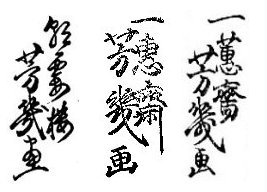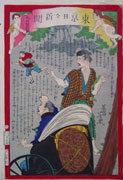Prints in Collection
Koko ga Edo Koude no Tatehiki, 1863 IHL Cat. #672 | Gosho no Gorozo, 1864 IHL Cat. #409 | Tsuru no chitose Soga no kadomatsu, 1865 IHL Cat. #715 |
IHL Cat. #2062
IHL Cat. #458Showing the Flag,
No. 849 Tokyo Nichi Nichi Shinbun, 1874
IHL Cat. #408
Married in Next World,
No. 862 Tokyo Nichi Nichi Shinbun, 1874
IHL Cat. #421
Business Trip to Saga, Hizen Province,
No. 913 Tokyo Nichi Nichi Shinbun, 1875
IHL Cat. #2061
Angry Sumo Fan Demands Refund,
No. 1050 Tokyo Nichi Nichi Shinbun, 1875
IHL Cat. #1288
Biographical Data
Biography
Utagawa Yoshiiku 歌川 芳幾 (1833-1904)
Sources: William Wetherall's News Nishiki website http://members.jcom.home.ne.jp/yosha/nn/almanac/Almanac_whos_who.html; The Hotei Encyclopedia of Japanese Woodblock Prints, Amy Reigle Newland, Hotei Publishing Company, 2005, p. 505.
 | Utagawa Yoshiiku was a Japanese printmaker and illustrator. As a printmaker, he designed a wide range of prints including those depicting bijin (beautiful women), musha (warriors), yakusha (actors), and the sensationalized pictures of blood-stained mayhem called chimidoro-e and muzan-e, among others. From 1874 to 1875 he designed nishiki-e shinbun for the Tokyo newspaper Nichinichi Shimbun, which he co-founded.1 He was the son of a teahouse proprietor and attended the printmaking school of Utagawa Kuniyoshi (1798-1861) along with Yoshitoshi Tsukioka (1839-1892), six years his junior. From this time dates a life-long rivalry with Yoshitoshi whom, it is reported, he bullied at school. Whether or not this allegation has any foundation, there would have been a natural rivalry between the two artists, particularly coming up in the same school, and competing for the master's (and later society's) recognition. In the late 1860s, Yoshiiku and Yoshitoshi collaborated on the production of the Eimei nijuhasshuku series. Throughout the next two decades, they often shared the same writers and publishers. It was not the sort of world in which they could have let any bitterness between them get in the way of their work. |
His works include the prints Kokkei Wanisshi-ki (滑稽倭日史記) Comical Record of Japanese History, which employs the traditional theme of Hyakki Yakō2 on contemporary Japanese military actions in China.
Hispupils included Ikumaru (active c. 1865-1873), Ikukatsu (active c.1880s), Kobayashi Ikuhide (active c. 1885-1898), and the female artistIkutoshi (active c. 1860s).
Artist's Names and Signatures
Yoshiiku's most common signatures were Keisai (恵齋) Yoshiiku and Ikkeisai (一恵斎) Yoshiiku. Other names included Utagawa Yoshiiku, Chokaro, Sharakusai [Sairakusai], Keiami, Ochiai Yoshiiku 落合芳幾 (full name), Ochiai Ikujiro 落合幾次郎 (real name).(with seal: Yoshiiku) Hans Olof Johansson's website http://www.ukiyo-e.se/signatur.html |  Keisai Yoshiiku 恵斎芳幾 (with seal: Yoshiiku) |  (with seal: Yoshi kiri paulownia flower seal used by Kuniyoshi) |  from left to right: “Chōkarō Yoshiiku ga” (朝霞楼 芳幾 画) “Ikkeisai Yoshiiku ga” (一恵斎 芳幾 画) “Ikkunsai Yoshiiku ga” (一薫斎 芳幾 画) Wikipedia website http://en.wikipedia.org/wiki/Utagawa_Yoshiiku |
1 The founders of "Tokyo nichinichi shinbun" are: JOHNO Denpei (1832-1902, pseud. "Sansantei Arindo" as gesakusha: popular fiction writer), NISHIDA Densuke (1838-1910, former clerk of TSUJI Den'emon's kashihon'ya: lending library), and OCHIAI Ikujiro (1833-1904, pseud. "Utagawa Yoshiiku" as ukiyoe print artist). (Source: Waseda University Library Rare Material Collection website http://www.wul.waseda.ac.jp/collect/b10/7017-7125-e.html) For information on nishiki-e shinbun and early Meiji newspapers see Nishiki-e shinbun and Newspapers in Meiji Japan
2 an old folk belief, dating from the Heian period (794-1185), that one night each summer all sorts of terrifying beingsmake their way to the mountains to enjoy themselves with games andamusements, parading around at night and dispersing before dawn. Japanese artists have rendered scenesof demonic creatures romping and cavorting at night through the Meiji period (1868-1912).














